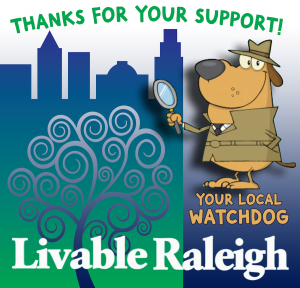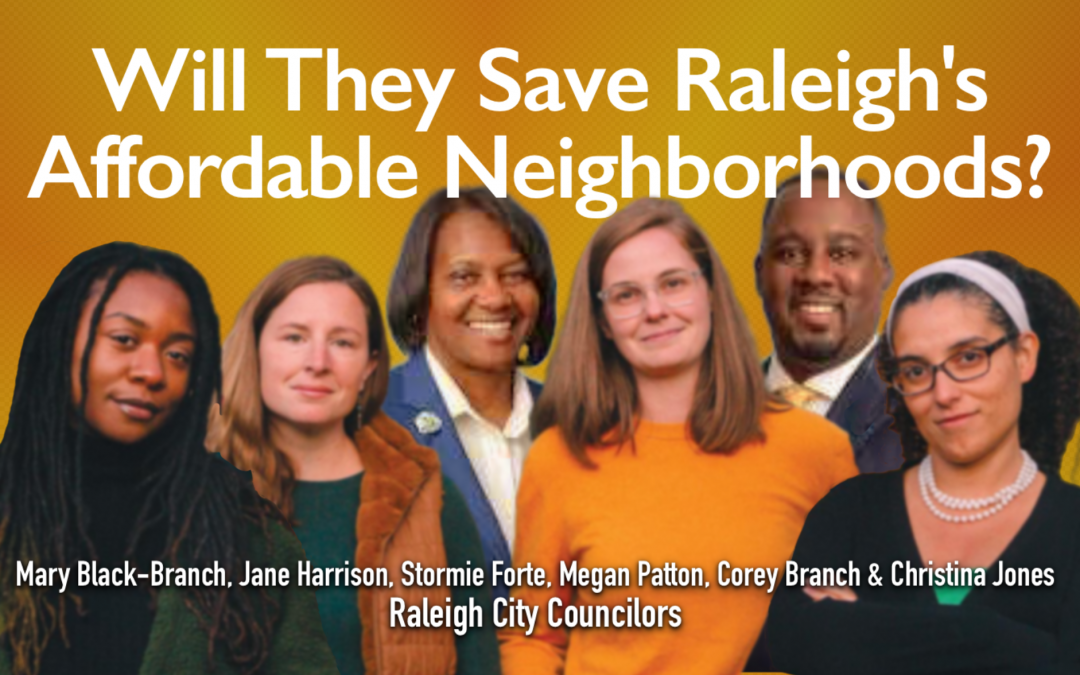
Bob Geary is a founding member of Livable Raleigh, former member of Raleigh’s Planning Commission and a former Indyweek columnist.
Here he writes about his thoughts on Raleigh’s Dix Edge Area Study.
There are some good ideas for promoting equitable development and housing affordability hidden in plain sight in the Dix Edge Area Study.
For example:
-
- The idea that a model Public Benefits Agreement – read: Affordable Housing – be part of all significant rezonings (p. 73).
- The idea of a zoning overlay district to protect the at-risk older neighborhoods from teardowns (p.25).
Unfortunately, these good ideas are lost under the one driving force that animates the 107-page study, which is to “pave the way (literally) for more high-rise developments and hope, but not insist, that affordable housing gets in there somehow.”
I’m paraphrasing, but that’s the gist of what the city’s planning and development staff produced.
As the report itself states:
“The Dix Edge Area Study has two important goals with regards to the future land use vision. The first is to plan for and manage the significant intensification envisioned for the area. … The other is to be responsive to the needs of residents of the existing neighborhoods along South Saunders Street, keeping equity and neighborhood stabilization in the forefront of growth….”
But wait! Keep equity in the forefront? C’mon, equity isn’t anywhere in the picture so far, nor will it be without strong policy commitments by City Council.
And in this vein, the Dix study is maddeningly obtuse. Its good ideas for equity are not spelled out, nor are they even recommended. Rather, they are tossed out off-handedly, and dismissively, as topics to be “explored,” “considered,” or “encouraged.”
For example, developers should be “encouraged” to include affordable units of housing in their plans.
Encouraged how?
Well, there’s the rub.
While the good ideas are given short shrift, however, the series of “action items” for intensification are spelled out in great detail (a new “Form and Function Map,” for example; new “Urban Centers,” “urban corridors” and a cheerleading Comprehensive Plan amendment), all intended to pave the way for more high-rise, high-density luxury projects – with affordability little more than an afterthought.
If these “action items” beat the “good ideas” into city code, they will shut the door on any equitable future Dix Edge might’ve had.
Cutting to the chase: Pell-mell growth near Dix Park needs no help from city planners. Equity, on the other hand, is on life support.
The challenge for City Council, therefore, is to lift up the good ideas, flesh them out, and make them law first, and quickly, before it’s too late – before the onslaught of speculative rezoning cases is allowed to doom all of the “Naturally Occurring Affordable Housing” (NOAH) in the Dix Edge area and preclude any new affordable housing from coming in.
Let’s be clear, it may be too late already. The Dix Edge study should’ve been completed in 2015, when Raleigh finally acquired the former Dorothea Dix Hospital site and its 325 acres of land from the State of North Carolina. The acquisition capped a decade-long process during which it was always clear that, if and when a Dix Park came to fruition so close to downtown, a land rush would follow in the adjacent neighborhoods – the low-rise, lower-income neighborhoods of Fuller Heights, Caraleigh and Maywood – that are east and southeast of Dix.
Well, the land rush is well underway, with big chunks of the low-rise neighborhoods rezoned for massive new development in the three years after Mayor Baldwin was elected in 2019.
Massive projects, that is, like Downtown South, which was approved by the Baldwin Council for up to 40-story buildings and an estimated 16,000 new housing units, but with zero concern for equitable development and zero units committed to affordable housing.
In the 2022 elections however, Baldwin’s loyalists lost half of the Council seats and Baldwin herself was barely re-elected.
The ‘22 election marked the end of the era of “anything goes” development in Raleigh, or it should’ve, given the degree to which the scourge of high-rise luxury development approvals is wiping out affordable homes and gentrifying formerly affordable neighborhoods across Raleigh.
Now, the new City Council has a chance to change the rules of the game. Specifically, it should put the destructive rezonings on pause, and adopt new policies that assure:
-
- All rezonings, if approved, include healthy quantities of new or preserved housing units affordable to every income level, not just the affluent. (That’s what the idea for a model Public Benefits Agreement would entail. Any development applicant would be expected to offer it as part of a rezoning scheme. Council needs to spell out the model.)
- NOAH units, whether houses or apartments, can be preserved and renovated with financing from the City where necessary. Raleigh can’t require NOAH owners to fix up their places. But without a robust public fund for repairs and renovation, NOAH in Dix Edge is an endangered species.
- As a means of preserving NOAH and fostering the construction of additional affordable houses and apartments, the City should be an active bidder for land in the Dix Edge area, either taking ownership itself or ceding it to a land trust dedicated to the mission of affordable housing.
A strong land trust.
The promise of financing to fix up small affordable homes.
An overlay district that limits building heights next to existing low-rise neighborhoods.
A model public benefits agreement that Council will expect developers to attach to all major rezoning applications.
The number one public benefit they should offer: Affordable Housing. The bigger the rezoning, the more affordable units.
Recently, Indyweek seemed unhappy that Council “stalled” the Dix study and referred it to a Council committee over Baldwin’s strenuous objections. Read it here: Dix Edge Area Study Stalled
Did the writer really think that adopting the study as it stands would be a positive step?
I’m sure she did. I “encourage” her to read it again.
As it stands, the Dix study would do little more than say to developers, “Keep doing what you’re doing” and the city will help grease the wheels.
We don’t need a study for that. The wheels are fully greased.
What we do need, and fast, is a thoughtful revision of the study that puts the brakes on pernicious development while it puts in place – in the zoning code and related policies – a strong set of policies to insure that development will henceforth serve the broad public interest, and not just its investors.
The Council’s Growth and Natural Resources Committee will take up the Dix Edge study Tuesday, Feb. 28 at 4 p.m. The meeting is in-person but will also be streamed. Details here: GNR Committee Meeting
This committee, like all the other Council committees, was dormant for the past three years at Mayor Baldwin’s insistence. But it may now come alive again with newly elected Council member Jane Harrison (District D) as chair. Dix Edge is in District D.
If you appreciate the kind of reporting we bring to you
|
Please donate $10 or $20, Thanks for supporting |
 |

